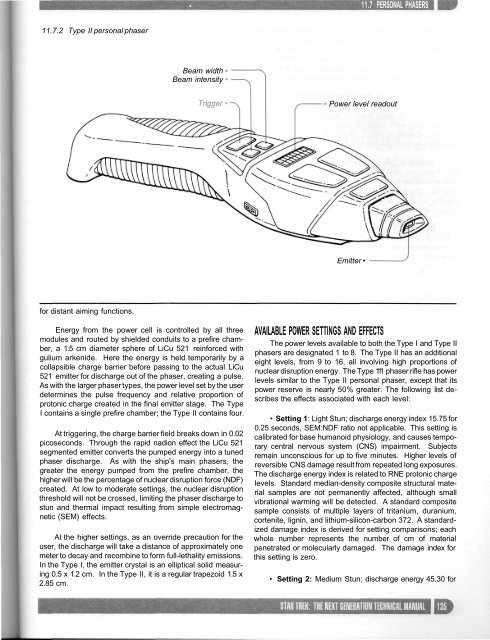franchise-star-trek-tng-technical-manual1
franchise-star-trek-tng-technical-manual1
franchise-star-trek-tng-technical-manual1
You also want an ePaper? Increase the reach of your titles
YUMPU automatically turns print PDFs into web optimized ePapers that Google loves.
11.7 PERSONAL PHASERS11.7.2 Type II personal phaserBeam widthBeam intensityPower level readoutEmitter •for distant aiming functions.Energy from the power cell is controlled by all threemodules and routed by shielded conduits to a prefire chamber,a 1.5 cm diameter sphere of LiCu 521 reinforced withgulium arkenide. Here the energy is held temporarily by acollapsible charge barrier before passing to the actual LiCu521 emitter for discharge out of the phaser, creating a pulse.As with the larger phaser types, the power level set by the userdetermines the pulse frequency and relative proportion ofprotonic charge created in the final emitter stage. The TypeI contains a single prefire chamber; the Type II contains four.At triggering, the charge barrier field breaks down in 0.02picoseconds. Through the rapid nadion effect the LiCu 521segmented emitter converts the pumped energy into a tunedphaser discharge. As with the ship's main phasers, thegreater the energy pumped from the prefire chamber, thehigher will be the percentage of nuclear disruption force (NDF)created. At low to moderate settings, the nuclear disruptionthreshold will not be crossed, limiting the phaser discharge tostun and thermal impact resulting from simple electromagnetic(SEM) effects.At the higher settings, as an override precaution for theuser, the discharge will take a distance of approximately onemeter to decay and recombine to form full-lethality emissions.In the Type I, the emitter crystal is an elliptical solid measuring0.5 x 1.2 cm. In the Type II, it is a regular trapezoid 1.5 x2.85 cm.AVAILABLE POWER SETTINGS AND EFFECTSThe power levels available to both the Type I and Type IIphasers are designated 1 to 8. The Type II has an additionaleight levels, from 9 to 16, all involving high proportions ofnuclear disruption energy. The Type111 phaser rifle has powerlevels similar to the Type II personal phaser, except that itspower reserve is nearly 50% greater. The following list describesthe effects associated with each level:• Setting 1: Light Stun; discharge energy index 15.75 for0.25 seconds, SEM:NDF ratio not applicable. This setting iscalibrated for base humanoid physiology, and causes temporarycentral nervous system (CNS) impairment. Subjectsremain unconscious for up to five minutes. Higher levels ofreversible CNS damage result from repeated long exposures.The discharge energy index is related to RNE protonic chargelevels. Standard median-density composite structural materialsamples are not permanently affected, although smallvibrational warming will be detected. A standard compositesample consists of multiple layers of tritanium, duranium,cortenite, lignin, and lithium-silicon-carbon 372. A standardizeddamage index is derived for setting comparisons; eachwhole number represents the number of cm of materialpenetrated or molecularly damaged. The damage index forthis setting is zero.• Setting 2: Medium Stun; discharge energy 45.30 for


